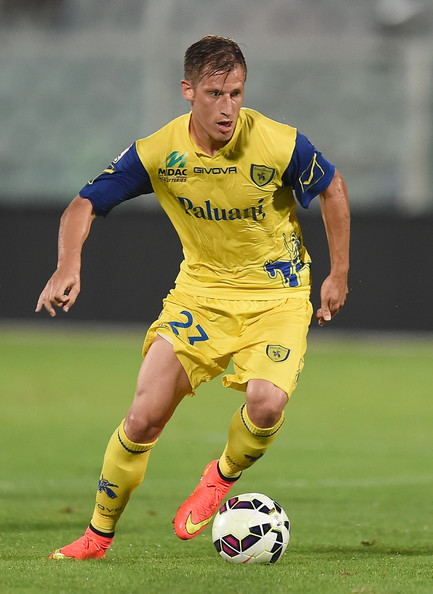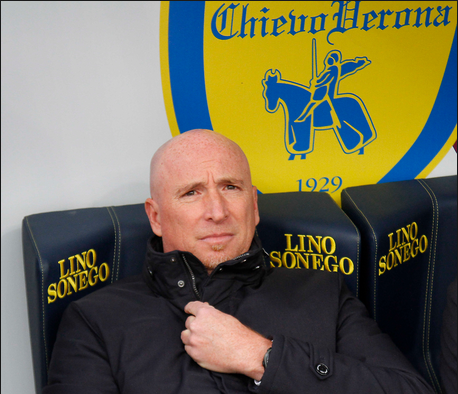Chievo are a great example of a team that have had a fantastic turnaround in fortunes this season, and provide a good example as to how to manage your way up the table. The recipe for a successful and consistent league campaign, at least in Serie A, has to come from two directions – hard work, mental attitude and cohesion but also to implement this correctly through tactics and disciplined training. Maran seems to have captured this plan very well this season, bringing together the emphasis on high-energy & hard-work with tactical shape and familiarity in matches.
Maran’s approach centres around pressing from the front – one which should be reasonably familiar – but this is broken down into sections and works well on an individual basis as well as effecting the shape of the team as a whole. A key point here is that it is the responsibility of the strikers (usually Paloschi and Meggiorini) to decide when to push up and pressure the opposition on the ball in their half, and when to drop off. The theory behind this is that no team can maintain this sort of energy and closing down for 90 minutes, and the strikers are the first point of contact when the opposing defence gain possession. If Chievo’s front men need a rest, they drop off the pressure and the midfield falls back into shape behind them. When they are ready again to press, they check that the midfield is relatively organised and if so they go and try to reclaim the ball. It sounds simple, but it is a good cue for the rest of the team to stabalise, regroup and maintain a good structure when they are defending, without getting caught open. It doesn’t all rely on winning back possession either, as the high pressing serves to hurry the opposition into making longer passes, whilst also leaving the two strikers high up the pitch for counter-attacking. Meanwhile, the midfield tend to stay in a compact diamond shape which can congest the centre of the pitch.
Centre-back Gamberini spoke during an interview that the Chievo back-line know defence starts from the front, and that the balance of play and the resulting movement of the rest of the team depend on how easy it is for the opposition to break out of their own half with the ball. He said that ‘closing doors’ and positioning is relative to the work of his own team’s forwards. Its an important concept, and although many people acknowledge ‘building from the back’ and working the ball out of defence, through midfield to the strikers in order to create chances on goal – we don’t tend to think of the reverse for the defending team. Maran’s style does really well at targeting the correct areas on the pitch as to where his side need to put the high-intensity in to try and win the ball back, taking into account things like the flow of the game, how many men are out of position and how expansive the play has become in the preceding attack.
Something that has become much more apparent this season for Chievo is that they play the same against any opposition – a point which Maran has highlighted. The reliance on team work-ethic and tactical consistency means that although you would think that they just drop back into a defensive shape and hold out for 90minutes, it often frees up players like Birsa and Hetemaj at certain periods in the game to break forward and become more creative. All of their key defensive work is done off the ball, which leads to more structured build up where they can work on controlling the ball and distributing it correctly when they regain possession. Rigoni generally sits in front of the back four after he has done well to carve out a first team slot amidst injuries in the squad, but it is Castro that has emerged as a key man due to his work-rate and dynamism in midfield. He and Hetemaj can be very important in the transitional phases where Chievo look to make a difference and gain an advantage over the opposition. It will be interesting to see how M’Poku fits into the team when he returns from injury – he may well be limited to providing an attacking option from the bench, so as not to upset the balance of the team. A more influential component is Birsa – a creative force going forward, one which Maran recognized after the first game of the season when he changed to a diamond shape to accommodate the Slovenian further forward.
Amongst all the good that has been achieved so far, early into the season, there are areas for Chievo to improve. If we take Juventus’ defence, just for an example, Barzagli and Chiellini are particularly reactive to danger when defending ‘their space’. Chievo’s defence would seem to benefit greatly from having this same sort of mindset and pro-active protection near their goal, particularly defending low crosses into the box. Their set-piece play is a bit of a conundrum – they can be poor at defending balls coming into their area – but they can also be particularly dangerous to their opposition at the other end. Paloschi and Meggiorini are both decent headerers of the ball, and the latter along with Birsa can both put in a good cross.
Classic case in point is the Genoa game, in which Chievo lost 3-2 despite playing most of the second half with an extra man. They start by scoring extremely early – ball through the middle, comes loose and Meggiorini reacts quickest. He takes the ball, pulls out wide and zings in a nice low cross for Paloschi to poach at the near post. Then comes the opposite at the other end. Genoa break down their left far too easily, Rigoni is scared to put in a tackle in the box, a low cross comes in and after a bit of a scramble Pavelotti is the only one moving towards the ball & reacts first to score the equalizer.

Genoa take the lead a few minutes later with another goal that will disappoint Maran. A wishy-washy cross makes it to the edge of the Chievo penalty area, but Cesar’s clearance is poor and the ball comes straight out to an opposition player. From there, the goal is a bit of a lucky deflection, but the Chievo defence don’t know where they are going and end up with 3 players next to each other half-heartedly trying to block the shot. The defensive line starts off good, but when they have to deal with one man on the overlap, one man running towards goal and one man on the ball – they don’t coordinate quickly enough and it all looks a bit sloppy.
There’s no doubt about it, Chievo’s equalizer was a fantastic finish from Pellissier – a back flick as the ball is behind him, with a great deal of power. This goal again comes from a cross to the near post, this time by right-back Mattiello coming forward, and Pellissier gets in ahead of his man. They have demonstrated that they can be one of the best in the division at crossing and gaining an extra yard in and around the six-yard box to poach goals – by head or foot.
However, despite dominating possession and having almost twice as many shots on goal, ten-men Genoa take the lead in injury time. Again, they break too easily down their left and manage to cut the ball back, where no one is picking up the two men lurking on the edge of the area. Chievo have men back, but they allow the two opposition players to go unmarked and unchallenged as they get a shot away into the goal. They appear to be organized and prepared, but drop too deep and don’t engage the threat. This is what ultimately costs them goals – they get stand-offish in dangerous situations around their own penalty area. The defensive players also sometimes struggle with the movement of the opposition attackers, like we saw at times against Inter with Icardi, Perisic and particularly Jovetic. Although Maran said he was happy with the work ethic and performance of his players, he will know they should never have lost the Genoa game, and ironing out these common mistakes is something that would separate Chievo from mid-lower table to challenging for Europe.


